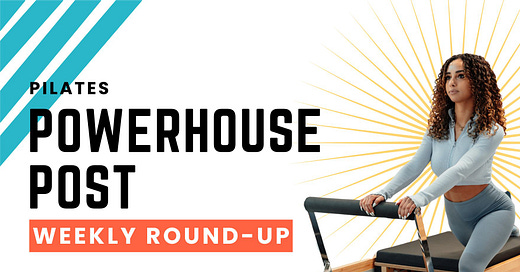Hey there!
Welcome to the Powerhouse Post, my weekly round-up of all things Pilates industry related. Read on for the latest headlines and some of my commentary.
Cheers, Kaleen
On Socials
📸 Kerry Washington posts clips of her Pilates workout.
In the News
🦴 Can Pilates prevent Osteoporosis? Women’s Health investigates (tldr; yes with caveats)
Pilates Biz
🧠 Les Mills gets a writeup in Athletech News explaining how they’re incorporating mind-body fitness into their programming.
From Kaleen’s Blog
🔎 If we want Pilates to grow and be taken seriously as a movement method, we need to study it just like other forms of fitness. However, there are some major limitations to getting good data. I outline these limitations in this week’s blog Pilates Deserves Better Science, and share three EASY ways to interpret whether a Pilates study might be worthwhile reading (no PhD required).
Research and Tech
❤️🩹 Let’s walk through a recent study using the three guidelines I outlined in this week’s blog on interpreting Pilates research. This study showed that a 12-week Mat Pilates program for older, hypertensive adults significantly improved key measurements of gait speed, blood pressure, and functional status. However, can we trust these results? Let’s see.
What is the study comparing Pilates to? ❌ There were two groups in this study: The Mat Pilates group and the Control group. The Mat Pilates group did 30-mins of Mat Pilates followed by 30-mins of aerobic exercise three times per week for 12 weeks. The Control group engaged in “moderate aerobic activity” for the 30-minutes, three times per week. Immediately we can see that Mat Pilates was being set up to succeed by comparing it to nothing (Mat Pilates+Aerobic Exercise vs. Aerobic Exercise alone). Both groups got aerobic exercise, and only one got Mat Pilates.
How is “Pilates” defined in the study? ✅ Specific Pilates exercises were clearly assigned to the experimental group. And because it’s a single study not a literature review, homogeneity across studies is moot.
Was the study designed well? ✅ The study was a randomized, controlled trial which is the gold standard. It is prospective (meaning designed at the beginning to test a hypothesis) and included a statistically significant number of patients in a clearly defined demographic.
Conclusion: This study was well designed and clearly articulated the Pilates component. It showed that Pilates has an overwhelmingly positive effect on hypertensive older adults. However, because the Mat Pilates group was compared against a group that did essentially nothing (instead of a different form of exercise) all we can conclude is that Pilates can help patients with hypertension (which makes sense, most forms of resistance training have tons of amazing benefits) but we can’t conclude it is the ONLY way or the BEST way to improve outcomes in that situation.
Do your classes meet expectations?
Find out how your class design stacks up by using my FREE Class Design Report (CDR)



